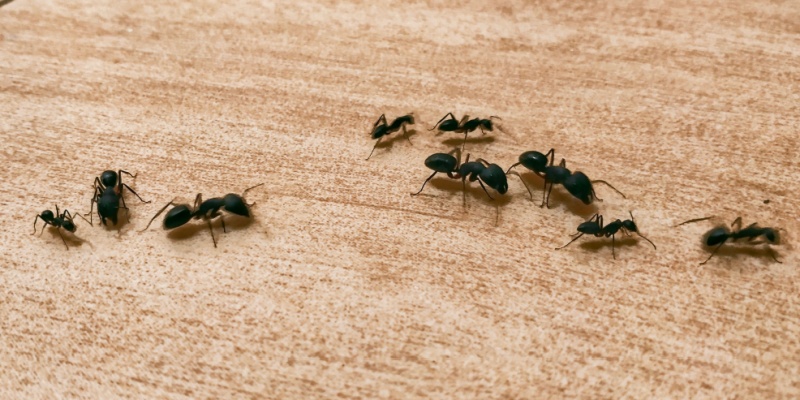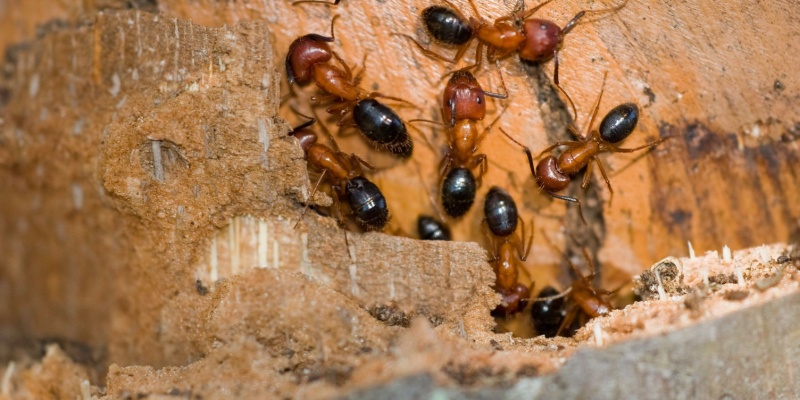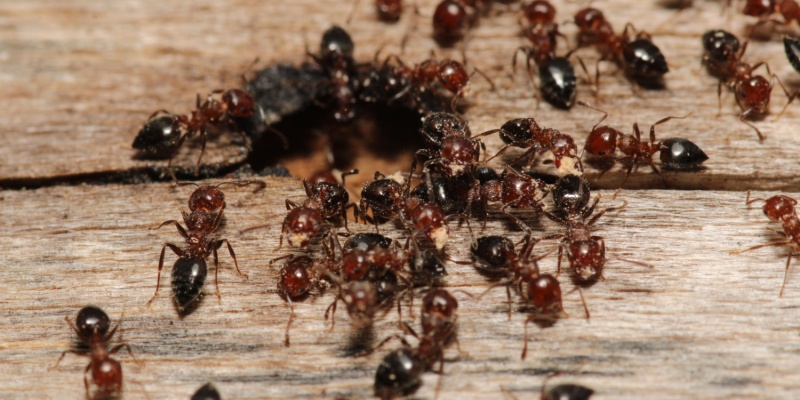Carpenter ants can cause significant damage to Portland homes over time, often working silently behind walls for years before homeowners realize they have a problem. Unlike termites, carpenter ants don’t eat wood but excavate it to create nesting galleries, which can weaken structural components of your home. At Atlantic Pest Control, we’ve helped countless Portland homeowners identify and eliminate carpenter ant infestations before they cause extensive damage.
Why Carpenter Ants Thrive in Portland, ME
Portland’s proximity to wooded areas and our humid coastal climate creates ideal conditions for carpenter ants. These industrious insects initially target wood that has been compromised by moisture or decay, making homes with water damage particularly vulnerable. Maine’s severe weather conditions, including heavy rain and ice dams, can create entry points and moisture issues that attract these destructive pests.
Key Warning Signs of a Carpenter Ant Infestation
Early detection is crucial for preventing serious structural damage. Here are the primary indicators that carpenter ants have taken up residence in your Portland home:
1. Visible Ant Activity
The most obvious sign is spotting large black or reddish-brown ants inside your home, particularly in kitchens, bathrooms, or near windows. While carpenter ants may be dark red with a black abdomen rather than entirely black, they’re typically larger than other household ants, measuring between 1/4 to 1/2 inch in length.
Remember that carpenter ants are mostly nocturnal, so seeing them during daylight hours could indicate a large, established colony. If you notice these large ants consistently, it’s time to investigate further.
2. Wood Damage Evidence
Finding sawdust-like material (called frass) on the floor below tiny holes in your walls is a telltale sign of carpenter ant activity. This material consists of wood shavings, insect parts, and debris that ants push out of their galleries as they excavate.
Unlike termite damage, carpenter ant galleries are smooth and finished, almost as if they’ve been sanded. If you tap on wood and it sounds hollow or feels soft, this could indicate carpenter ant tunneling behind the surface.
3. Rustling Sounds Within Walls
If you hear faint rustling noises coming from your walls, especially at night, this could be the sound of carpenter ants at work. Often compared to crinkling cellophane, these noises are more noticeable at night when the ants are most active.
This audible evidence is particularly common with large infestations, where hundreds or thousands of ants might be moving through their network of galleries behind your walls.
4. Winged Ants (Swarmers)
When flying ants appear inside your house or even outside, it’s a clear sign that there is an active carpenter ant nest nearby. Flying ants are the reproductive members of the colony and will “swarm” in order to mate and establish more nests.
Finding winged carpenter ants indoors, especially in late winter or early spring, almost certainly indicates an established nest within your home. After mating, these reproductive ants will shed their wings, which you might find scattered near windows, doors, or light fixtures.
5. Moisture-Damaged Wood
Carpenter ants are attracted to water-damaged or decaying wood, which is easier for them to excavate. If your Portland home has experienced water intrusion, leaky pipes, or condensation issues, it becomes particularly vulnerable to carpenter ant infestations.
Check areas such as window sills, door frames, bathroom fixtures, and roof eaves for signs of moisture damage that might attract these pests.
6. Visible Wood Deterioration
As infestations progress, you may notice more obvious signs of structural damage:
It’s only when you notice your windows and doors are beginning to stick, your floors are dipping or feel spongy, or your walls are starting to bulge that you might realize there’s a severe carpenter ant infestation.
By this point, the damage can be extensive and costly to repair, underlining the importance of early detection and treatment.
7. Ant Highways
Established carpenter ant colonies create well-defined trails (often called ant highways) that they use to travel between their nest and food sources. These paths might be visible along baseboards, pipes, electrical wires, or tree branches touching your home.
Where to Look for Carpenter Ants in Portland Homes
Carpenter ants typically establish nests in damp or decaying wood with high moisture content. Inside Portland homes, common nesting locations include wall voids, door casings, window sills, porch pillars, and crawlspaces. They are also frequently found in bathrooms, kitchens, and laundry rooms where moisture levels are higher.
Don’t overlook exterior areas like tree stumps, woodpiles, and landscaping timbers, which can harbor satellite colonies that eventually move indoors.
Why Professional Inspection Matters
While these signs can help you identify a potential problem, professional inspection is often necessary to:
- Locate the primary nest and any satellite colonies
- Assess the extent of structural damage
- Identify moisture sources contributing to the infestation
- Develop an effective, targeted treatment plan
Simply spraying visible ants with store-bought products won’t solve the problem. You must treat the entire infestation—especially the parts you cannot see because they’re behind walls or in locations not easily accessible.
Atlantic Pest Control’s Carpenter Ant Solution
Our comprehensive approach to carpenter ant control includes:
- Thorough inspection to identify all nesting sites and evaluate the severity of the infestation
- Targeted treatments that reach hidden nests and eliminate the entire colony, including the queen(s)
- Preventative measures to address moisture issues and seal entry points
- Follow-up monitoring to ensure complete elimination
For Portland homeowners, prompt action at the first sign of carpenter ants can save thousands in structural repairs. If you’ve noticed any of these warning signs, contact Atlantic Pest Control today for a professional inspection and effective carpenter ant elimination plan tailored to your home’s specific needs.


